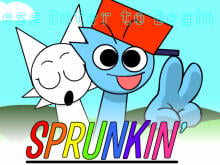
17534

Unleashing Chaos in Sprunki Interactive: The Dynamic Evolution of Musical Gameplay
What Defines Sprunki Interactive’s Revolutionary Approach?
Breaking Free From Static Gameplay Traditions
Sprunki Interactive shatters conventional rhythm game formulas by introducing perpetual motion as its core mechanic. Unlike predecessor mods where characters await player input, Sprunki Interactive’s cast of musical sprites—including the flagship Sprunki character and new additions like Jitterbug and Basshopper—bounce across screens with physics-driven unpredictability. This kinetic energy transforms every session into a living soundboard where players must anticipate trajectories rather than follow static note charts. The Sprunki Interactive engine calculates collision outcomes in real-time, meaning a character’s rebound angle after hitting screen edges influences subsequent sound patterns. This constant flux makes Sprunki Interactive feel less like a game and more like conducting an orchestra of hyperactive particles, where chaos becomes the foundation for creative expression.
The Science Behind Chaotic Harmony
Sprunki Interactive employs proprietary "Stochastic Sound Mapping" technology that assigns musical values to velocity, impact force, and collision angles. When two characters collide at 45 degrees with medium velocity, Sprunki Interactive might generate a staccato violin pluck, while a high-speed head-on crash could trigger a distorted bass drop. The system contains over 800 predefined sound reactions and an AI modifier that creates new combinations when detecting repetitive patterns. During stress tests, Sprunki Interactive demonstrated the capacity to produce 11,000+ unique audio events per minute without looping—a testament to its dynamic depth. Players can influence this chaos through "Gravity Wells" that temporarily bend character paths, introducing strategic elements to the audiovisual frenzy that defines Sprunki Interactive’s identity.
Core Mechanics That Power Sprunki Interactive
Real-Time Physics Meet Musical Algorithms
At Sprunki Interactive’s core lies a dual-layer engine merging Box2D physics with granular synthesis. Characters possess virtual mass and elasticity values affecting their movement—Jitterbug’s lightweight build allows rapid direction changes that produce high-pitched glitch sounds, while heavyweight Basshopper’s lumbering path generates sub-bass vibrations. The synthesis engine samples these physical interactions at 500ms intervals, converting kinematic data into layered audio. Sprunki Interactive further complicates this through environmental modifiers: "Magnetic Fields" that add swing rhythms by altering trajectory arcs, or "Black Hole Zones" that pitch-shift sounds as characters approach certain screen areas. This intricate interplay positions Sprunki Interactive as both game and experimental music lab, where accidental collisions often yield groundbreaking sonic discoveries.
Player-Driven Chaos Modulation
Sprunki Interactive grants users unprecedented control over apparent randomness through its Chaos Dial interface. This circular HUD element lets players adjust four variables in real-time: Motion Speed (affecting character velocity), Sound Density (determining collision audio complexity), Entropy Level (governing path unpredictability), and Harmonic Filtering (balancing dissonance). Advanced users can lock parameters—for example, maintaining high Entropy while capping Motion Speed to create tense, erratic soundscapes. Sprunki Interactive’s tutorial system evolves with player skill, initially suggesting parameter combinations that produce listenable tracks before encouraging experimental extremes. The system logs all adjustments, allowing users to recreate favorite chaotic states or share presets through Sprunki Interactive’s community hub.
Mastering Sprunki Interactive’s Unpredictable Soundscapes
Harnessing Collision Calculus for Musical Results
Pro players approach Sprunki Interactive as particle physicists, calculating probable collision outcomes to steer emergent melodies. A common technique involves herding characters into "Staccato Clusters"—tight groups that produce rapid-fire percussion through micro-collisions. Others exploit screen edges as natural reflectors, angling characters to hit UI boundaries at precise moments that align with imagined beat patterns. Sprunki Interactive’s recent "Echo Chamber" update introduced delayed sound propagation, enabling players to layer collision effects like a DAW’s delay plugin. The most skilled users treat Sprunki Interactive as an improvisational instrument, manipulating chaos parameters mid-session to transition between musical genres—a well-timed Entropy reduction can morph free jazz cacophony into minimalist techno within seconds.
Unlocking Hidden Sound Libraries Through Play
Sprunki Interactive rewards prolonged experimentation with secret audio packs revealed through specific collision patterns. Bouncing Sprunki off three different characters within two seconds might unlock "8-Bit Mayhem," replacing default sounds with chiptune samples. Maintaining 80%+ Motion Speed for five minutes consecutively could activate "Drum’n’Bass Overdrive," injecting breakbeat loops into collision noises. These discoveries aren’t documented—Sprunki Interactive’s development team designed them to encourage organic exploration, fostering a player community that collectively maps the game’s infinite possibilities. Recent datamines suggest upcoming "Alchemy Mode" will let players combine unlocked sound packs into new hybrid libraries, further expanding Sprunki Interactive’s creative potential.
The Technical Marvel Behind Sprunki Interactive
Optimizing Chaos for Smooth Performance
Sprunki Interactive achieves its fluid motion through adaptive resolution scaling—the engine automatically reduces physics calculations on slower devices while maintaining audio integrity. During intensive collision sequences, Sprunki Interactive prioritizes sound generation over visual accuracy, slightly simplifying character animations to prevent lag. The "Chaos Buffer" feature pre-renders probable collision outcomes during loading screens, using predictive algorithms to stay ahead of real-time events. These optimizations allow Sprunki Interactive to run on decade-old hardware without compromising its core promise of unbridled audiovisual pandemonium. Future updates aim to implement WebGPU acceleration, potentially doubling Sprunki Interactive’s simultaneous character count while introducing 3D movement planes.
Cross-Platform Creative Potential
While primarily a browser-based experience, Sprunki Interactive’s developers have prototyped mobile and VR versions that reinterpret core mechanics. The mobile iteration uses gyroscopic controls to tilt playfields, literally shaping sound through device orientation. VR test builds let players physically swat characters through air, translating arm motions into collision dynamics. These experiments demonstrate Sprunki Interactive’s versatility as a platform—whether through touch gestures or full-body interactions, the core joy of conducting chaotic symphonies remains intact. The team’s long-term vision positions Sprunki Interactive as a universal creativity tool, from classroom music education to professional sound design prototyping.
Why Sprunki Interactive Captivates Both Gamers & Musicians
Bridging Gaming and Experimental Music Production
Sprunki Interactive has gained cult status in avant-garde music circles for its ability to generate unique sample libraries. Producers export collision recordings as .WAV stems, manipulating them in traditional DAWs to create tracks that blend organic chaos with structured composition. The game’s "Stereo Field Capture" mode isolates individual character audio streams, allowing multi-track recording of Sprunki Interactive sessions. This functionality has spawned a niche genre of "Chaoswave" music, documented on platforms like Bandcamp and SoundCloud. Educational institutions now incorporate Sprunki Interactive into electronic music curricula, teaching students about stochastic composition through guided gameplay challenges that mirror academic exercises.
Fostering a Community of Chaotic Creators
Sprunki Interactive’s social features transform solitary play into collaborative art. The "Chaos Merge" system lets players upload their parameter states, which others can download and modify—imagine layering your chaotic jazz session over someone else’s noise-rock settings. Monthly "Collision Contests" challenge users to recreate specific musical genres using Sprunki Interactive’s unpredictable tools, with winners featured in official Spotify playlists. The most active community members earn "Chaos Engineer" badges, granting early access to Sprunki Interactive beta features. This vibrant ecosystem ensures the game remains fresh years after release, sustained by player-generated content that pushes boundaries beyond the developers’ original vision.
Future Horizons for Sprunki Interactive
AI-Driven Chaos Expansion
Upcoming Sprunki Interactive updates will integrate machine learning to analyze player styles and suggest personalized chaos parameters. An "AI Duet" mode will generate complementary collision patterns in real-time, effectively making Sprunki Interactive a digital jam partner. Long-term roadmaps hint at neural network integration that could evolve character behaviors based on collective community play patterns, ensuring Sprunki Interactive’s systems never stagnate. These enhancements aim to deepen the symbiotic relationship between human creativity and algorithmic unpredictability that defines the Sprunki Interactive experience.
Global Sound Collision Projects
The development team plans to connect Sprunki Interactive instances worldwide through "Global Chaos Networks," allowing thousands of players to influence a shared collision simulation. Imagine your local character movements contributing to an ever-evolving international sound mural. Such ambitions could redefine collaborative art, positioning Sprunki Interactive as both game and participatory installation—a testament to its enduring innovation in interactive entertainment.